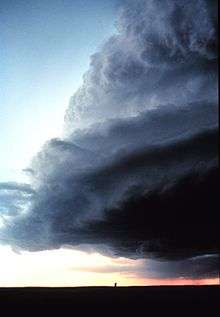Aeromancy
Aeromancy (from Greek ἀήρ aḗr, "air", and manteia, "divination") is divination conducted by interpreting atmospheric conditions. Alternate spellings include arologie, aeriology and aërology.[1]

Practice
Aeromancy uses cloud formations, wind currents and cosmological events such as comets to attempt to divine the future.[2] There are sub-types of this practice which are as follows: austromancy (wind divination), ceraunoscopy (observing thunder and lightning), chaomancy (aerial vision), meteormancy (meteors and shooting stars), and nephomancy (cloud divination).[2]
History
The first recorded instance of the word aeromancy being used was found in Chambers, Cycl. Supp, 1753. It was defined as "That department of science which treats of the atmosphere", rather than a form of divination.[1] However, variations on the word have been used throughout history with the earliest instance being in the Bible, though the practice is thought to have been used by the ancient Babylonian priests.[2][3]
Damascius, the last of the Neoplatonists, records an account of nephomancy in the 5th century CE, during the reign of Leo I:
Wherefore one finds a woman in the days of Leo the Roman emperor who knew neither by sense of hearing nor by the ancient practices the art of divination by clouds. The woman came from Aigai in Cilicia, having come from the family of the Orestiadai who dwell on the mountain at Komana in Cappadocia. Her family went back to the Peloponnese. She took thought for a man entrusted with a military command who was sent with others to the war against the Vandals in Sicily. She prayed to foresee the future by dream and prayed facing the rising sun. Her father prescribed and commanded her in a dream to pray toward the west. When she prayed, a cloud from the upper air stood around the sun, and became enlarged and took the shape of a man. Another cloud sheared off and rendered itself of equal size and took the shape of a wild lion. It went into a great rage and, having made a great chasm, the lion swallowed the man. The human, cloud-made shape was like a Goth. A little more about the apparitions; Thereupon the emperor Leo slew Aspar himself, the hegemon of the Goths (in Constantinople) and his children. From that time Anthusa has continued until now without interruption to practice the custom of mantic predition through clouds.[4]
Cultural influence
Aeromancy was mentioned in Deuteronomy 18 as being condemned by Moses.[3] It is also condemned by Albertus Magnus in Speculum Astronomiae, who describes the practice as a derivative of necromancy.[5] The practice was debunked by Luis de Valladolid in his 1889 work Historia de vita et doctrina Alberti Magni.[6]
In Renaissance magic, aeromancy was classified as one of the seven "forbidden arts," along with necromancy, geomancy, hydromancy, pyromancy, chiromancy (palmistry), and spatulamancy (scapulimancy).[7]
In myth
- Tinia, the Etruscan god of lightning
- Adad, the Babylonian god of thunder, lightning, and prophesy
- Amun, the Egyptian god of wind, fertility, life, and secrets
- Aditi, Hindu goddess of the sky
- Agni, Hindu god of the fire
- Thor, Norse god of thunder
- Zeus, Greek god of the sky and thunder
- Vayu, Persian yazata of the wind and atmosphere
- Perun, Slavic god of thunder
References
- Howard, Edwin J. (December 1942). "Four Words in Coxe's a Short Treatise... of Magicall Sciences". Modern Language Notes. The Johns Hopkins University Press. 57 (8): 675. JSTOR 2910532.
- "Aeromancy". The Element Encyclopedia of the Psychic World. Harper Element. 2006. pp. 8–9.
- Friedenwald, Harry (January 1942). "Apologetic Works of Jewish Physicians". The Jewish Quarterly Review. University of Pennsylvania Press. 32 (3): 237. JSTOR 1452355.
- Damaskios (1967). Clemens, Zintzen (ed.). Damascii vitae Isidori reliquiae [Damascius's Life of Isidore]. Bibliotheca Graeca et Latina suppletoria (in Greek and Latin). 1. Hildesheim, Germany: Georg Olms. p. 98. hdl:2027/mdp.39015010334483. ISBN 978-3-487-01585-9. OCLC 555183228. OL 19832802M.
- Thorndike, Lynn (July 1927). "Alfodhol and Almadel: Hitherto Unnoted Mediaeval Books of Magic in Florentine Manuscripts". Speculum. Medieval Academy of America. 2 (3): 327. JSTOR 2847724.
- Collins, David J. (Spring 2010). "Albertus, Magnus or Magus? Magic, Natural Philosophy, and Religious Reform in the Late Middle Ages". Renaissance Quarterly. The University of Chicago Press. 63 (1): 1–44. doi:10.1086/652532. JSTOR 10. PMID 20527358.
- Johannes Hartlieb (Munich, 1456) The Book of All Forbidden Arts; quoted in Láng, p. 124.